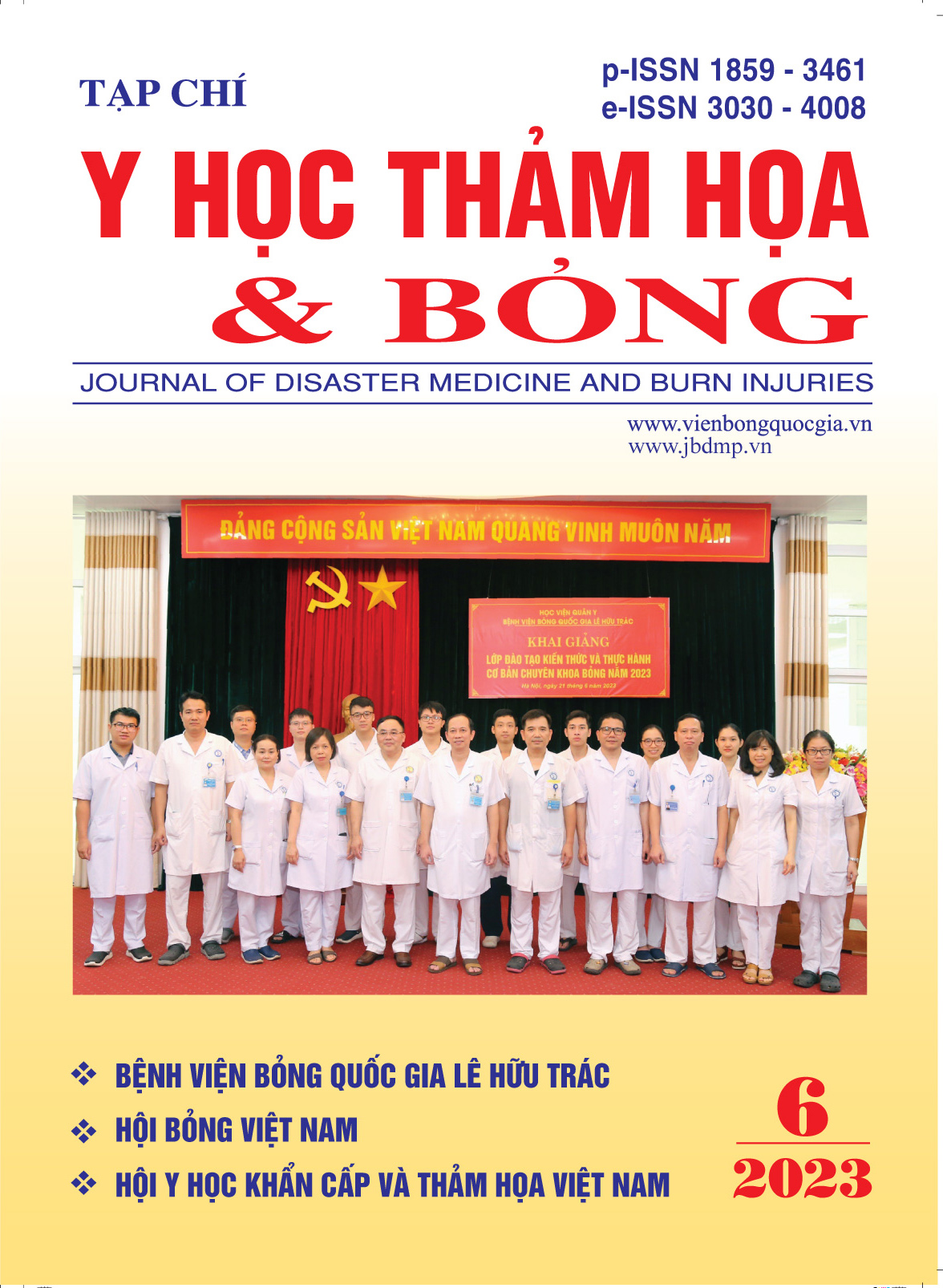Evaluation of the changes of SpCO index in patients with inhalation injury
Nội dung chính của bài viết
Tóm tắt
Objective: Evaluate the variation of SpCO index with clinical symptoms, medical support pre-hospital, and mortality rate of inhalation injury patients.
Subjects and methods: Prospective descriptive study with longitudinal follow-up in inhalation injury patients at the Intensive Care Unit - Le Huu Trac National Burns Hospital from March 2022 to May 2023. 50 patients with inhalation injuries were hospitalized within the first 72 hours. Patients were treated according to the treatment regimen for inhalation injury and CO poisoning. Subclinical and clinical symptoms were recorded and compared. The data was processed using STATA 16.0 software.
Results: The average SpCO index upon admission in the study patients was 15.7%. 24 patients admitted to the hospital before 5 hours had an average SpCO index was 8.3 ± 7.6%. 88% of patients were hospitalized within 12 hours of the accident. Medical support pre-hospital: Oxygen supply 63.3%, endotracheal intubation 35% and mechanical ventilation 25%. Respiratory assessment indicators including SpO2 and average PaO2 were high and had no statistical difference. Patients with a severe grade of inhalation injury have a high SpCO index upon admission. The mortality rate was high (> 70%) and the SpCO index at admission has no relationship with mortality rate.
Conclusion: Patients with CO poisoning were hospitalized early, the SpCO index decreased over time and did not correlate with treatment outcome. Patients with more severe inhalation injuries had a higher SpCO index upon admission. Symptoms are non-specific mortality rate was high, causing confusion and making it difficult to diagnose and predict inhalation injury patients.
Chi tiết bài viết
Từ khóa
Carbon monoxide poisoning, inhalation injury
Tài liệu tham khảo
2. Zorbalar, N., Yesilaras, M., & Aksay, E. (2014). Carbon monoxide poisoning in patients presenting to the emergency department with a headache in winter months. Emergency Medicine Journal, 31(e1), e66-e70.
3. Dries, D. J., et al. (2013). Inhalation injury: epidemiology, pathology, treatment strategies. Scandinavian journal of trauma, resuscitation and emergency medicine, 21(1), 31.
4. YAVUZ, E. (2018). Carbon Monoxide Poisoning. Eurasian Journal of Toxicology, 1(1), 1-6.
5. Moberg, M. E., Hamilton, E. B., Zeng, S. M., Bryazka, D., Zhao, J. T., Feldman, R., ... & Mubarik, S. (2023). Global, regional, and national mortality due to unintentional carbon monoxide poisoning, 2000–2021: results from the Global Burden of Disease Study 2021. The Lancet Public Health.
6. Nguyễn Như Lâm và cộng sự (2021). Các yếu tố ảnh hưởng đến tử vong và vai trò tiên lượng của chỉ số rBAUX đối với bệnh nhân bỏng hô hấp. Tạp chí Y học Quân sự, (352), 27-30.
7. Wise, B., & Levine, Z. (2015). Inhalation injury. Canadian Family Physician, 61(1), 47-49.
8. Rehberg, S., Maybauer, M. O., Enkhbaatar, P., Maybauer, D. M., Yamamoto, Y., & Traber, D. L. (2009). Pathophysiology, management and treatment of smoke inhalation injury. Expert review of respiratory medicine, 3(3), 283-297.
9. Mlcak, R. P., Jeschke, M. G., Mandel, J., & Finlay, G. (2020). Inhalation injury from heat, smoke, or chemical irritants. UpToDate, 1-22.
10. Piatkowski, A., Ulrich, D., Grieb, G., & Pallua, N. (2009). A new tool for the early diagnosis of carbon monoxide intoxication. Inhalation toxicology, 21(13), 1144-1147.
11. Feiner, J. R., Rollins, M. D., Sall, J. W., Eilers, H., Au, P., & Bickler, P. E. (2013). Accuracy of carboxyhemoglobin detection by pulse CO-oximetry during hypoxemia. Anesthesia & Analgesia, 117(4), 847-858.
12. Papin, M., Latour, C., Leclère, B., & Javaudin, F. (2023). Accuracy of pulse CO-oximetry to evaluate blood carboxyhemoglobin level: a systematic review and meta-analysis of diagnostic test accuracy studies. European Journal of Emergency Medicine, 10-1097.
13. Hanley, Mary E., and Pujan H. Patel. "Carbon Monoxide Toxicity." (2017).
14. Jor, H. M., & Dalton, H. R. (2008). Headache and drowsiness in a 22-year-old student. BMJ (Clinical research ed.), 337, a1481.
15. Moon, J. M., Chun, B. J., & Cho, Y. S. (2020). Is an increased PaO2 in a normobaric state safe in acute CO poisoning? Basic & Clinical Pharmacology & Toxicology, 126(5), 448-457.
16. Mehta, S. R., Das, S., & Singh, S. K. (2007). Carbon Monoxide Poisoning. Medical journal, Armed Forces India, 63(4), 362-365.
17. Endorf, F. W., & Gamelli, R. L. (2007). Inhalation injury, pulmonary perturbations, and fluid resuscitation. Journal of Burn Care & Research, 28(1), 80-83.


